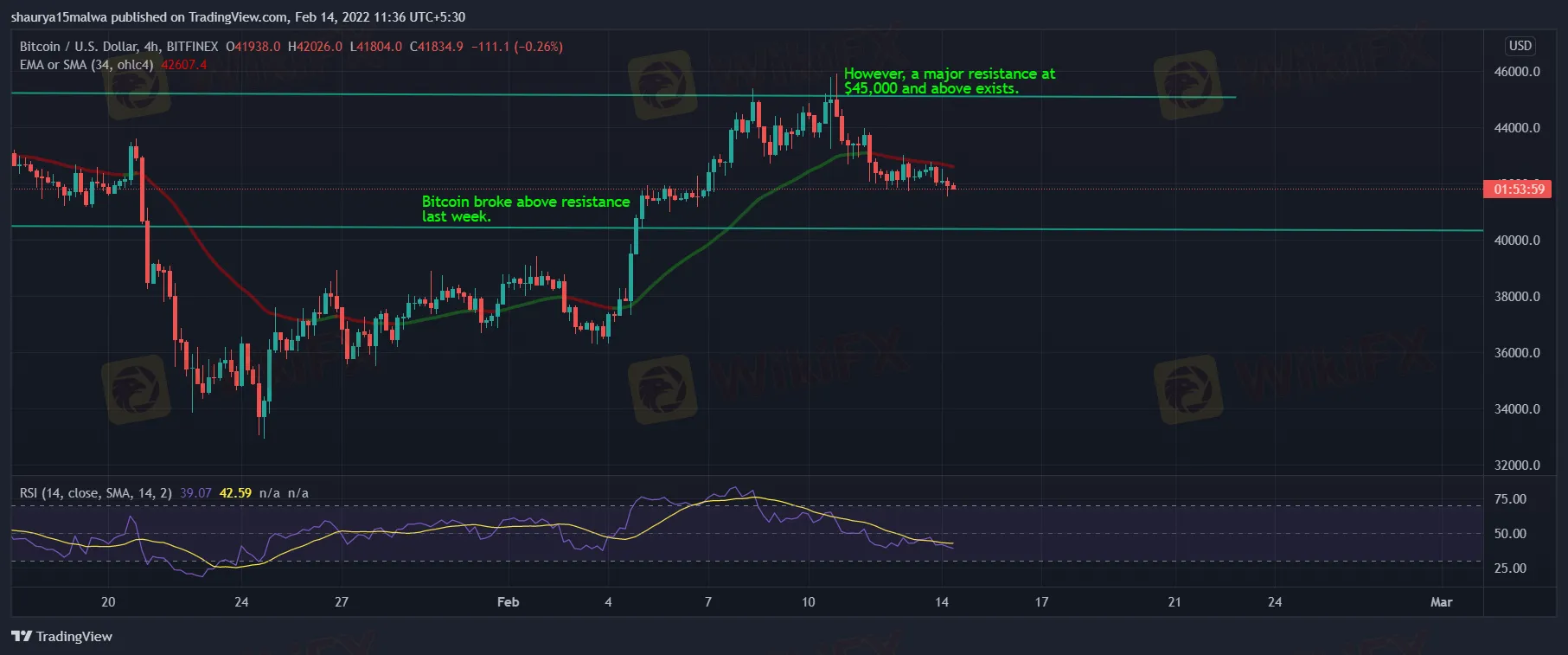简体中文
繁體中文
English
Pусский
日本語
ภาษาไทย
Tiếng Việt
Bahasa Indonesia
Español
हिन्दी
Filippiiniläinen
Français
Deutsch
Português
Türkçe
한국어
العربية
Bitcoin holds above $41k as hashrate surged to all-time highs
Abstract:held above the $41,500 resistance level over the weekend after a slide from the $46,000 level last week. The move came as hashrates for the Bitcoin network hit lifetime highs.

Bitcoin has shown strength this month after a slide to yearly lows of $33,000 in January. It broke above the $38,000 and $41,500 resistance level in the first week of February to monthly highs of $46,000, a level previously seen in the final weeks of 2021.
Traders have since taken profits on the move as bitcoin saw weekly lows of $41,600 in early Asian hours on Monday but recovered to nearly $42,000 in afternoon hours.
RSI, or Relative Strength Index, levels showed readings of 39 on Monday, suggesting an end to the weekend slide and a continuation of the uptrend to the $48,000 level.
RSI is a price-chart indicator that calculates the magnitude of price changes. Readings above 70 suggest an asset is “overbought” and could see a correction, while below 30 imply “oversold” wherein assets may recover.
The weekend price action came as surged to new all-time highs, as per data from analytics tool YCharts. Hashrates are a measure of the computing power required to mine blocks on the Bitcoin network, and higher rates make it much more difficult for singular entities to try and control the network in the so-called “51% attack.”
Hashrates hit 248.11 million terahashes per second (TH/s) on Saturday, increasing from the 180 million TH/s level from last week. It currently hovers at 209.63 million TH/s, falling 15.51% in the past 24 hours, data show.

Bitcoin hashrates have increased by over 50% in the past year. As of last July, miners based in the U.S. accounted for 35.4% of the hashrate on the network.

Disclaimer:
The views in this article only represent the author's personal views, and do not constitute investment advice on this platform. This platform does not guarantee the accuracy, completeness and timeliness of the information in the article, and will not be liable for any loss caused by the use of or reliance on the information in the article.
Read more

Want to be Sure of a Forex Settlement Process? Read This IMPORTANT Guide!
Forex settlements are complex—and missteps can cost millions. This guide breaks down CLS, the global standard in FX settlement, so you can reduce risk and streamline cross-border transactions.

8 Golden Rules to Rule in the Forex market
These are important rules that most people won’t tell you. Whether you’re new to Forex beginner or have been trading for a while, these tips can help improve your trading journey. Read this article to learn the key rules every trader should keep in mind.

Top Tips to Choose the Best Forex Broker in 2025
You need a solid forex broker to make the most of the currency fluctuation. The strategies they use to take you through the ups and downs of forex trading are beyond words. While the strategies may seem solid, the eventual gains matter more. That’s where you need to take notice of the forex brokers, how they approach, their fee structure, rating, etc. To help you evaluate forex brokers better, we have this guide for you. Read it to choose the right forex broker in 2025.

Blockchain Decentralization: Empowering a Trustless Future
In recent years, blockchain technology has rapidly evolved from a niche innovation behind Bitcoin into a transformative force across industries. At its core, blockchain decentralization refers to the distribution of authority and decision-making away from a central entity and into the hands of a distributed network of participants. This shift redefines how data is stored and verified and paves the way for trustless, transparent, and resilient systems that challenge traditional centralized models.
WikiFX Broker
Latest News
CNBC Daily Open: The silver lining of positive earnings could be too blinding
Brexit made businesses abandon the UK. Trump's hefty EU tariffs could bring them back
CNBC Daily Open: Solid earnings beats might mask tariff volatility these two weeks
Mastering Deriv Trading: Strategies and Insights for Successful Deriv Traders
Jeep-maker Stellantis expects first-half net loss of $2.7 billion as tariffs bite
U.S. doubles down on Aug. 1 tariffs deadline as EU battles for a deal
Buffett and Thorp’s Secret Options Strategies
Trading Market Profile: A Clear and Practical Guide
CNBC Daily Open: Investors dismiss Trump administration's beef with the Fed — S&P hits new high
Sharing Trading Mistakes and Growth
Currency Calculator


